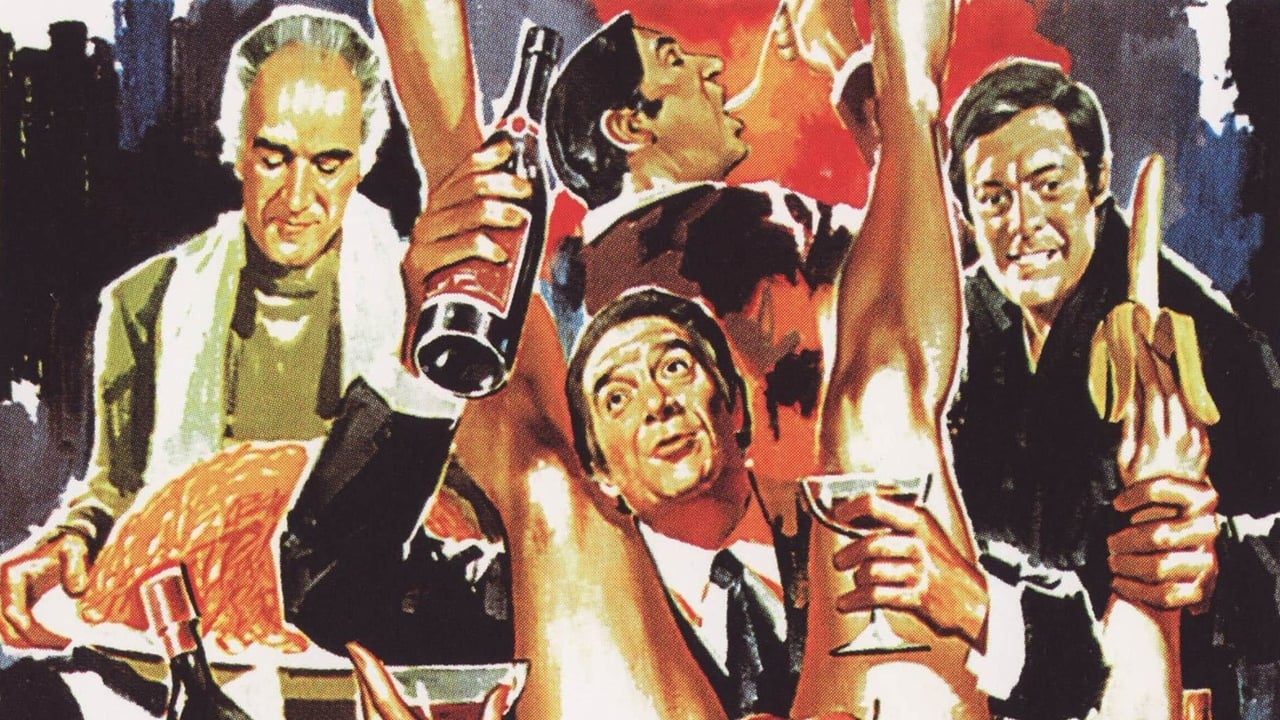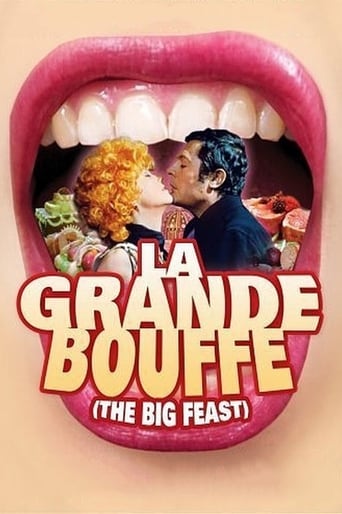zetes
The two other Marco Ferreri films I've seen, Dillinger Is Dead and Bye Bye Monkey, I found utterly boring, I must admit. I was a little wary of La grande bouffe, though I had always wanted to see it. I've always been drawn to stories where a group of people (or more usually a couple) lock themselves up together and slowly kill themselves, or screw each others brains out. In this film, four men (Marcello Mastroianni, Michel Piccoli, Philippe Noiret and Ugo Tognazzi, all playing characters who use the actors' real first names) come together in a palatial estate to screw prostitutes and eat themselves to death. No real reason is given. The prostitutes don't make it very long. The constant feasting disgusts them, and they leave. The only woman who does stay is a Reubenesque teacher named Andrea (Andrea Ferreol), who is intrigued by both the food and sex (unlike the other women, the idea of food and sex together turns her on). This movie is a tad too slow. At it's best, though, it's fascinating and hilariously gross. Food seems quite unappetizing after about a half hour of this. I loved the performances. Definitely of interest.
Crap_Connoisseur
Marco Ferreri is one of my all time favourite directors, for both his fearlessness in pushing boundaries and his piercing originality. Ferreri's greatest achievement was making relentlessly intellectual films that also managed to entertain. While many other European directors could get caught up in their own genius, Marco Ferreri was never pretentious enough to forget about his audience.La Grande Bouffe is one of Ferreri's best and most notorious films. The premise is infamous, four friends gather at a country mansion with the intention of literally eating themselves to death. When this becomes tiresome they hire three prostitutes and invite the local school teacher to join them. This is not a film that follows a linear narrative, instead it expertly crafts a sense of atmosphere from a series of acutely observed vignettes. There are enough unforgettable images and surreal happenings in this film to make Salvador Dali green with envy. The meat garden, Andrea and Michel's flatulent love making and Philippe's relationship with his nanny are just three that come to mind. There is genius at work here, this is not an exercise in empty symbolism but a disturbing slice of modern life.The impact of La Grande Bouffe has not wearied with age. The sex scenes are possibly less confronting (although Marcello's inventive use of a champagne bottle still raises eyebrows) but the film's psychological impact has not been dulled. The characters' ruthless pursuit of death is all the more disturbing given their unadulterated appreciation for life's pleasures. For a film with such disturbing content, La Grande Bouffe is also effortlessly entertaining. Ferreri somehow manages to balance the building tension with black humour, raunchy sex scenes and even budding romance.This is probably a good time to mention the cast. Ferreri has gathered together a who's who of European cinema. Ferreri regulars like Mastroianni and Tognazzi combine brilliantly with French heavyweights like Piccoli and Noiret. Andrea Ferreol more than matches it with these acting giants. She deserves significant credit for her illuminating performance as the open minded school teacher with the appetite of a blue whale.La Grande Bouffe is intelligent, disturbing and unrelenting. Most importantly, it is also entirely non-judgemental. Ferreri would never insult his audience by suggesting to them what they should think. If only more modern directors had taken note.
hamonkulus
Just a fact that you can see four of all best actors in unusual ugliness in the same movie,magnifies the interest to the picture.Never before Marcello Mastroianni acted so different role like here. Another fact -that all of the four personages are named the same as the actors,leads to the thought,that the actors and the director Marco Ferreri divided the same fillings on a subject of modern hight society,its eternal chasing after satisfactory which does not have limits include moral,and inability to get away of it. Like in another Ferreri movies,here there is no need to think,just to follow,and understanding will come. The picture is very good example for "different" cinema,although the one plus four biggest stars of the Europe and for my opinion of the world.
VR
This film is supposed to be a criticism against consumerist society. Well,it could have been done much better.In fact,few people even in the Western world afford&allow themselves to indulge with such delicacies, the most expensive champagne. It is therefore a criticism of capitalism not as it really is,but as it is wrongfully depicted in some Communist propaganda about Western "decadence".Note that the events in the film must take place , in the year 1972 or 1973,because its characters know "The Godfather:Part one".This means the affluent society just before the Oil Crisis put an abrupt ending to the almost thirty years of relentless economical growth after 1945.So,realesed in 1973,the subject would have already been dated.It would have been much better if Ferreri would have made this film in the 80's,because it fits the materialistic credo of the following decade.The idea of the middle-aged man contemplating suicide was well used in films ranging from "The Waltz of the Toreadors" to "Scent of a Woman".Here the suicide pact between four quite wealthy middle-aged men is just unrealistic,especially if there is no logical reason,no plan,no actual pact.Only one character has diabetes and he dies in the most quick and painless manner by eating an entire cake and then passing away as if he fell asleep,as if he wanted desperately to convince the audience that he's dead,when not only the actor but even the character seem to "fake it"(death of course).But we know nothing more of his ailment and if this is the actual reason. Nor do we know why the other three are doing this.Mastroianni should have stuck to "La Dolce Vita",there his character experiences another kind of death and suicide,not physically,slowly defeated by a pleasure-seeking society.This part was the criticism of consumerism without graphic violence,vulgarity,physical signs of pain.But in this film,also being called Marcello,like in Fellini's masterpiece,his part is becoming a tasteless copy of his former part,another,more fleshy Marcello.The death scenes are more of an insult to intelligence rather than disturbing.The viewer is supposed to believe that the four deaths are plausible,if a doctor or even a person without medical knowledge can tell that neither of the characters could die in real life like they did here.They seem to know far too good when exactly they are going to die to be for real!Besides,in every thorough scientific analysis of the symptoms before and in the moment they died it is clear that the cause of their death is just a big deceit.Praised for its divinely decadent mood,this very mood is rather shabby. The villa which is supposed to be a gateway into the decadent verse,of luxury,of vintage class&style looks awfully tasteless and unimaginative,a sterile visual experience completed by a bunch of underfed,dirty poultry running around.And the Bugatti that just drives back and forth without advancing,in a surreal way of defying the laws of mechanics and the very mission of even the worst car,when it should be a fast vehicle.A hint at Isadora Duncan's death?Or just a symbol for the fact the pact once made,trough some incredulous,inexplicable and unrealistic laws of destiny no one will leave the house alive?The food which also serves as suicide weapon is understated and rather unappetizing,though expensive compared to the real French-Italian gourmet cuisine.The literary symbols are also out of place:this film should be a modern Satyricon,but it lacks the picturesque style of the Roman masterpiece,the "Godfather"-imitation is too anecdotal and superficial and Boileau's oak and its story are completely redundant in the plot line,because the hint that Boileau's world of classical harmony is dead in our postmodern times is a too obvious truism.The spectacular factor of Satyricon-style banquets is also lacking.The film should be a warning against the "mortal sin" of gluttony. Actually it is both pathetic and deprived of any realistic expression or emotion,because a real-life French or Italian gourmet would relish all these foods and many more without dying,without even getting sick.Ironically,only hours after I saw the film I also embarked on a weekend of lavish eating and drinking in a secluded mountain villa with my friends and,almost needless to say,after having consumed similar quantities none of us dies or even got sick,lol!-of course there was no suicide pact in our case.No exceeding excess(though made in the materialistic eighties,years of overspending,the same film would have had another message and such quantities of food would not have been used for dying,rather as a status symbol or even a psychotherapy in favor of living).It fails to condemn materialism because neither its temptations are shown as appealing or sinful(and even less as deadly)nor is death due to them the slightest bit possible in real life,and also failing to bear any lessons against excessive greed.One ends up pitying not the basic needs and vices of the characters,nor their low morality,rather their immense tastelessness(even in death)and their unimaginative behavior exhaling mediocrity,essentially non-intellectual though their are supposed to be educated.The parallel between food and the forces of life and death,of eroticism and passion is key element in films ranging from the tragic "Como l'Agua para chocolate"(where food and recipes are present in the most disturbing and intense moments of the character's doom)up to that forgettable pseudo-entertainment called "Woman on top".In this film it was just misplaced and misused.Much more convincing films about how consumerism and the promise of material happiness in a shallow,ruthless society have a crippling impact on the individual,but not necessarily trough food and suicide pacts,like "Blow-up","La Dolce vita","Clockwork Orange","Scarface",Citizen Kane","Wall Street" or "American Beauty"-in all this masterpieces the characters are undergoing their own suicide without knowing,being dragged in the downward spiral of greed much more complex than for food,they may or may not be wiped out physically,but always(and in the long run much more painful)innerly.This film,on the other hand,where even the four deaths fail to be credible,is a shame,but fortunately an exception in the usually so artistically accomplished,so flawless European cinema.

